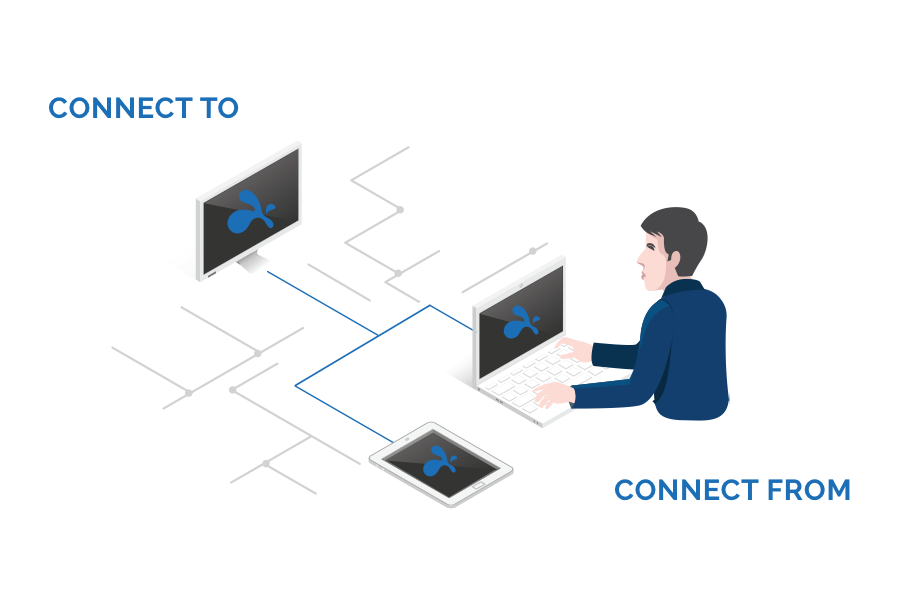Read the updated 2021 insights from this article here.
In a recent article, we explored the future of work with CEOs and HR leaders in diverse industries. Our findings? The office is not going away. Then what about the explosion of remote work? If the office is not going away, wouldn't that mean that remote work is not going to stick? Not necessarily. Ultimately, what we concluded from our discussion on the future of work is that the future is hybrid.
What is a hybrid office, and how can businesses prepare for setting up a hybrid workforce? As its name implies, the hybrid office is an office setup where employees have the flexibility to work from the office or anywhere else they have access to the tools they need to perform their work.
What are the security requirements and policies companies need to put in place? What type of office infrastructure should businesses put in place to get ready for the future of work? What are the equipment and tools needed to support it? Get an answer to all these questions and learn how to set up your hybrid office in 3 simple steps.
I. Outline a hybrid office policy
When COVID19 hit and forced businesses to go remote, the harder part was not to extend remote work capabilities; it was implementing it and guiding employees in the process. As many had not worked remotely before, they had no experience in how to do it productively. It was also quickly discovered that not all employees are fit to work remotely. By putting in place a hybrid office policy, employers can ensure that employees follow the right guidelines. Here is how you can set up a Hybrid Office Policy.
Clearly define who the policy applies to – Make it known which members of the company can work from home. Perhaps new employees are required to work in the office for the first 30 days to facilitate their onboarding? Maybe some positions cannot be remote? Whatever the answers to these questions are, make sure to add them to your policy.
Set expectations and guidelines for when employees can be remote and when they should be on promise work – When you are setting up your remote office, are you planning to have employees work three days from home and two days in the office? Are you thinking of putting in place an allowance for remote days and giving employees complete authority on when to use them? Or, do you want managers to define the remote allowance for their team? Are you planning to leave it completely open? Are there must-attend on-site meetings? How many hours should remote workers put in each day? There is a lot to consider. List out all of the possible scenarios and make sure to include guidelines for each item in your policy.
Communicate how employees will work from home - Should employees move their office provided computers to their remote locations or should they access it remotely as needed? Is there a remote desktop tool you have in place that they can use to access their computers remotely? What apps should team members use to communicate with each other? Whatever tools you have in place, make sure everyone knows what they are and how to use them.
Overemphasize on security – This is really important. We live in the digital age, and everyday hackers work harder to breach trough security walls. While there is no perfect security, don't make it easy for them. Make sure you follow all the security guidelines and keep up with them. Outline them in your policy and ensure your team knows how to follow such guidelines.
II. Revise your office space and configure it to meet your clearly defined goals
It goes without saying – but do you need a large office if employees only come a few days a week, perhaps even a few days a month? Probably not. So how do you make the most of your physical office space? You should explore the reasons why you wanted to have a hybrid office in the first place.
Life balance for employees? Social interactions? Robust security? Super-charged productivity? Reduced costs for your company? Why is this important? It will define how you set up your office space. That's how many partially remote businesses are configuring their workspace.
For instance, Base Camp's office is structured more as a meeting place than the traditional office setup. In an interview with FastCompany, Base Camps'CEO Jason Fried said that he designed his company's office to simulate what it would be like if nobody was actually at the office.
"If you're at home in a second bedroom or no one's around during the day, you're not distracted. You're in an environment you can control for the most part, and you work in isolation and get into deep work and [aren't] bothered by other people. We wanted to create an office space to simulate the advantages of that, but also give an opportunity for people to get together in a sound-controlled environment."
- Jason Fried, CEO at Basecamp.
So what does this mean for you? If your goals for setting up an office are the reasons we mentioned above, then you need to configure your office to promote collaboration, boost productivity, and security. This means the traditional side by side cubicle design is probably not going to make sense. You might want to opt-in for rotating desks, investing in more socially interactive spaces for employees to mingle and collaborate. Maybe that would mean replacing the coffee room with a lounge room?
And, if the office is used as a brand signal for impressing potential customers, perhaps you should invest in a state of the art conference room. Furthermore, if the office will be more empty than full, maybe you don't need as many meeting rooms? Also, If you plan to use your office to host a quarterly social, perhaps you should invest in building an amazing social space where your team can socialize quarterly. And obviously, you need to consider a design that will meet the highest sanitary regulations to protect your organization in situations like the current COVID19 pandemic.
These are just a few areas to explore. The bottom line is that you need to define what you are trying to accomplish and design your space accordingly.
III. Invest in the right tools and technology to efficiently support your hybrid team
What are the tools you need in place to allow your team to work remotely, productively, and securely? Should you buy remote computers and office computers for employees? Should you duplicate licenses for software used by your team so that they can use them both in the office or anywhere else they will be working from? These are the tools you need.
For Remote Access —> BYOD + Splashtop Remote Access
BYOD + REMOTE ACCESS = The perfect blend of technology to enable a hybrid workforce
For a long time, the traditional way of working remotely has been through a company’s VPN Network. This has been proven to not be optimal and scalable for enabling a remote workforce: VPN is costly so hard to scale and with unreliable performance. It has become obvious that remote access is the better and most optimal way to enable hybrid work. Here is how it works.
![Illustration of a person using a laptop, connecting remotely to a desktop monitor and a tablet. The words CONNECT TO and CONNECT FROM label the connections. All devices display the same logo on their screens.]()
Remote Access enables users to access work computers through any personal Windows or Mac computers or even iOS or Android mobile devices. This allows companies to leverage personal devices already available to employees ( laptops, tablets, smartphones). This set up has been trending for a while. It is called the BYOD - A Bring Your Own Device (BYOD) policy allows employees to access work-related networks or systems using their personal devices, such as laptops, smartphones, and tablets. With Remote Access and BYOD, there is no need to invest in duplicated devices or software licenses because when employees use remote access, they can connect to their on-premise computer and use it as if they were sitting in front of it.
What to look for when choosing a remote access solution —> Reliability, Security, Cost, and Ease of Use
While there are many remote access tools out there, most of them are either bulky, overpriced, or not secure enough. That's where Splashtop delivers. Splashtop is the best-value remote access solution of the market – with prices often 80% lower than the competition and enterprise-level security and features like 4K streaming for all remote sessions. You can find out more about Splashtop and our remote access solutions here as well as try them for free without any commitment or credit card required.
With that being said, here is what you should look for in any remote access solution, whether it is Splashtop or another one:
Single sign-on (SSO) capability, to ensure employee passwords meet compliance and security requirements
Device authentication; most VPNs do not have this capability
Multi-factor authentication
Support for BYOD (bring your own device) rather than requiring remote users to use company-issued devices to ensure security
Click-and-connect capability, as opposed to the painful setup, long times to connect, and often slow performance of VPN-based solutions
Automated infrastructure and software updates, because relying on manual updating, as is necessary with VPNs, not only exposes security risks but also causes downtime and compatibility issues
High-performance, low-latency solution able to support streaming HD video, thus improving user productivity
Fast, easy scalability for thousands of users
No requirement for setting up gateway hardware at each remote site
The ability for IT to control file transfers and remote print (i.e., disabling or enabling them)
Human-readable logs, session recording, and easy monitoring and reporting
For Project Management: ProofHub, Trello, Monday, and Workfront.
For Real-Time Communication: Slack, Skype, and Zoom.
For Collaboration: Google Drive, Microsoft Teams, and Confluence.
For Team monitoring & Management: Hubstaff, Officevibe, and JotForm.
You can learn more about all these tools here.
While this is a non-exhaustive list, it covers the crucial elements you should consider when setting your HYBRID OFFICE and enable your employees to work from anywhere productively. Have more questions and need help setting up your remote team? Contact us at any time. You can also get started with a free remote access trial by clicking the link below.





